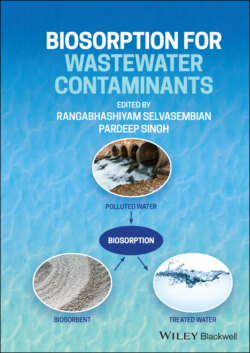Читать книгу Biosorption for Wastewater Contaminants - Группа авторов - Страница 31
Fungi as Biosorbents
ОглавлениеFungi are eukaryotic species that include yeasts, mushrooms, molds, and so on. They are used as biosorbents due to their distinguishing features: i.e. easy to grow, greater biomass yield, and ease of alteration either genetically or chemically (Mulligan et al., 2001). Both dead and living forms of fungi can be used as biosorbent material (Wang and Chen, 2006). The cell wall of fungal organisms possesses outstanding binding characteristics because of the presence of chitin, mannans, and glucans in addition to lipids, polyphosphates, and proteins (Javaid et al., 2011). The fungal cell wall is rich in polysaccharides (90%) and glycoproteins that contain different metal‐binding groups, such as amines, phosphates, carboxylate, and hydroxyls (Remacle, 1990). Active and passive metal absorption by fungi have been reported:
Active or intracellular absorption or bioaccumulation depends on the metabolism of the cell.
Passive absorption, or biosorption, involves metallic ions binding to the exterior of the cell membrane and is unrelated to cell metabolism.
Uptake of metals in active mode occurs only with living cells. In this circumstance, metal ions may bind with cell surface functional groups via ion exchange complex formation or simple physical binding. The metal absorption process, which is independent of energy, may be influenced by temperature, metabolic inhibitors, etc. (Shamim, 2018). Physical and chemical treatments such as thermal treatment, dimethyl sulfoxide, detergents, orthophosphoric acid, glutaraldehyde, formaldehyde, and alkali can alter the biosorption potential of fungal populations (Das et al., 2008). At the industrial level, fungi can be easily generated to adsorb metal ions from huge amounts of polluted supplies. Moreover, biomass can be created using inexpensive growth media or byproducts from a variety of fermentation processes. Furthermore, fungi are somewhat sensitive to nutritional variations as well as other process factors, including temperature, pH, and aeration. They are easily separated by simple techniques such as filtration due to their filamentous existence. As a result, they are also regarded as cost‐effective and environmentally beneficial biosorbents (Leitão, 2009). Table 2.3 lists some fungal species that have been utilized as biosorbents.
